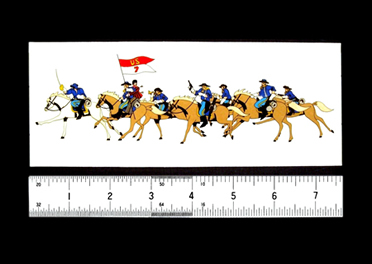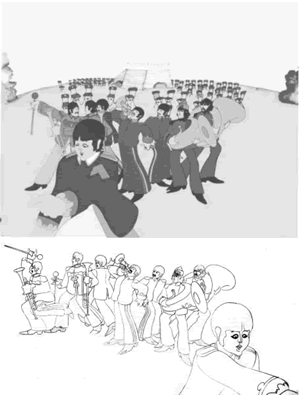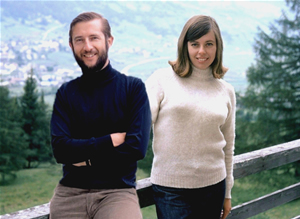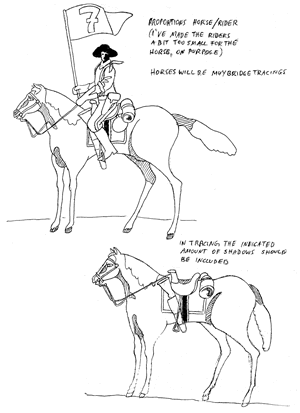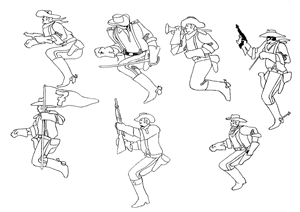These are a Few of My Favorite ScenesAs seen in Frames Per Second Magazine Part of the 40th Anniversary Series on “Behind the Scenes of the Yellow Submarine” by Dr. Robert R. Hieronimus author of Inside the Yellow Submarine: The Making of the Beatles Animated Classic It has been 40 years since the U.S. premiere of the genre-setting Yellow Submarine (November 13, 1968 in the U.S.), giving us the perfect opportunity to remember the unknown artists who poured their souls into this film. Yellow Submarine is if nothing else, one heck of a multi-layered film, so the stories behind the details are practically endless once you find the right co-creators with the good memories or (even rarer) a good journal. Since the 2002 publication of my book, I discovered several more co-creators whose stories have never before been published. Fortunately for our increased viewing pleasure the next time you watch the film, they all happen to be those kinds of people. For example, though we interviewed over two dozen co-creators for Inside the Yellow Submarine, it was not until one of our new discoveries that we heard the name of the little terrier dog playing with the portly, balding gentleman in ‘Eleanor Rigby.’ Several co-creators had told us that the man was one of the owners of the famous Dog and Duck pub where the crew practiced considerable alcoholic inspiration. But it was not until we met Australian Cam Ford that we learned that the dog was named Scrumpy. Ford said, “he was obviously named after the viciously potent draught cider of southern England,” and that “it was a particularly apt name, as Scrumpy was an animal of an exceptional anti-social disposition, who would wander around the crowded bar of the pub, biting customers on the leg as the whim took him and making evil smells.” Much has been made about the happy confusion that surrounded this production, especially in the first few months before a working script was revealed. Many of the co-creators recalled working on scenes randomly and having no real idea how they would fit into the finished film. Of course, the few top men on the project had a somewhat better grasp on the overall direction, but the majority of the crew enjoyed learning on the fly with their almost free creative reign, jumping from one colorful, zany scene after another. Tracer and painter Diana Ford remembered being assigned to the “Lucy” sequence: “It came as a great surprise when somebody said to me, ‘You’re going down to the Larkin's Studio in Covent Garden to do some Rotoscoping.’ Well, I had never heard of a Rotoscope before. And for those that haven’t, it’s a machine with a bicycle seat situated halfway up a wall with a desk with a glass screen in front of it, under which lies a projector with a film. The film images are projected upward onto the glass screen, and you lean forward on the bicycle seat with your Rapidograph [pen] and you trace them off frame by frame. I was there for three weeks perched up on my bicycle seat and I had no idea what I was doing. I was simply given a pen and positioned on this machine and told to trace off the images. I traced off horses, and donkeys, and Fred Astaire, and Ginger Rogers, and people riding a merry go round. And as the pile of cels that were traced grew, somebody would come and collect them and take them away.” Cam and Diana Ford are one of the many couples that blossomed out of the Yellow Sub crew that are going strong today. Cam remembers one of his favorite scenes was one that no one else wanted to do: the cavalry charge to save Ringo in the Sea of Monsters: “Nobody really wanted to do it because there was an awful lot of work in it – galloping horses and all sort of things. It was an extremely complicated sequence to animate, with a lot of drawing, but because I was (and still am) interested in the U.S. Civil War period, I took it on. At first it was intended to be just a simple ‘U.S.-cavalry-to-the-rescue’ gag, but, as the movie Custer of the West was screening in London at the time, I decided to give General Custer the opportunity for one last glorious charge, and gave the horsemen the 7th Cavalry flag to carry.” Canadian Norm Drew is another of our new discoveries since the publication of Inside the Yellow Submarine. Together with Scottish Animator Tom Halley, Drew shared an office part of the time with the Americans from King Features, Abe Goodman and Al Brodax. This gave him a unique perspective on the perennial struggle between the suits and the artists that has been so well documented elsewhere. Drew says one of his favorite scenes was the one in real life that repeated itself several times. He would come into work, and Al Brodax and Abe Goodman would be in a near panic, “when they heard Heinz [Edelmann, the film’s chief designer] had quit and gone back to Munich. I can still see Abe pacing office to office, sweating, and waving his cigar around, trailing smoke, pleading, ‘What? Where's he gone? We gotta get him back!’ And Al is on the phone at the desk opposite Tom’s and my desks, frantically calling around and trying to locate Heinz. As Heinz says [in the 2005 Animation World interview], he quit too many times to be taken seriously later.” Though one of the 135 crew members not to receive a screen credit, Drew immersed himself in the production more completely than many of the more laid back English animators (who were more religious about their pub breaks). He remembers being one of the few to work there very late at night, around the clock, going home to sleep only when the night guard kicked him out. In a similar way to Edelmann’s, Drew’s health also suffered severely as a result of those long hours and the psychic stress of making up an animated film without a script for several months. “Except for ‘Eleanor Rigby’ and ‘Lucy in the Sky’ I worked on every sequence and character. Lots of work on all the main characters, especially the Chief Meanie, the Glove, the Beatles, the Boob, Old Fred, and the Lord Mayor.” One of his most favorite, however, was the bump and grind he added to the burlesque lady on the necktie, in one of the pans across Pepperland. One of Tom Halley’s favorite memories was injecting a similar bit of whimsy to an otherwise standard pan across another scene, when he added arms doing the breast stroke to one of the fishes in the Sea of Monsters. With the many varied styles throughout this innovative and collaborative film there is something to visually delight almost everyone’s tastes. But it’s not until we hear the memories of the co-creators and they break these scenes down to their cel-by-cel components (which is how they remember the film) that we can truly appreciate some of the sweat and tears behind them. Inside the Yellow Submarine is available at amazon.com. Autographed copies and related items can be purchased from http://www.21stCenturyRadio.com/yellowsub, where you will also find the other 40th anniversary articles in this series. This article was prepared with the assistance of Jodi Brandon and Laura Cortner.
The same riders seen in color carrying Ringo full of arrows after the successful rescue. An actual production cel from Cam Ford’s work on the cavalry charge in the Sea of Monsters. Ford has this to say: “A horse gallop usually takes about 7 drawings to produce one cycle of movement, which can then be repeated as often as desired for the length of the scene. To make things a little easier to animate, I chose to have 7 riders and reuse the same basic horse animation for them all, but to make it visually more interesting I drew each horse at a different phase of the 7 frame gallop cycle. Since Heinz’s drawings were so complicated, I first animated the close-up scene of the Cavalry galloping right, and then had them photographically reduced onto high-contrast Kodalith film for the long shot, where they were so small that it would otherwise have been almost impossible to animate them. For the return to the Sub, the cels were simply flopped over and Ringo was added behind one of the riders. The scene was great fun to do, but, even with the time-saving techniques just described, it was still an awful lot of work, and took me nearly two weeks to animate! This cell is one of the small Kodalith film long shots of the cavalry and Ringo. The ruler has nothing to do with production; I only included it to show how small the image actually was.” |
The line drawing on the bottom is one of Cam Ford’s original animation drawings of the eight Beatles racing off in all directions to answer the call "Beatles to Battle". To preserve continuity with subsequent scenes by other animators, he had to reanimate the foreground Paul to make him run off screen left, as shown in the finished still above.
One of the infamous Heinz Edelmann model sheets for the cavalry charge animated by Cam Ford. Note the exactness of Edelmann’s detailed instructions.
A black and white outline drawing of the cavalry charge from Cam Ford’s original animation when traced onto animation cell, but before painting.
A series of Muybridge photographs of a galloping horse that illustrate designer Heinz Edelmann's instructions to use these for reference in the cavalry charge. |
